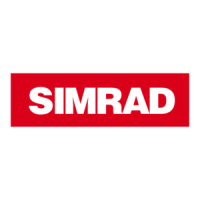to the telephone wiring in a house. If you pick up a phone in your
living room, you can hear someone talking into the phone in the
bedroom.
Network nodes: A network bus is built of network nodes spread
along a backbone i.e. displays and sensors connected to the back-
bone are called nodes. Wherever you want to add a new node,
simply separate the sockets of the old connection and attach your
new Tee Joiner or instrument between them. If you want to add a
node at the end of the line, remove the terminator from the very
last connector, securely attach the new Tee Joiner and then attach
the terminator on the new connector. Either method will allow you to
add a device. Further instructions on creating or expanding a net-
work are illustrated in the SimNet network setup booklet, or refer to
the display unit’s installation manual.
Note: An existing operational NMEA2000/SimNet bus will already
have terminators in place and will already be powered.
Do not add terminators or connect additional power to a functional
NMEA2000/SimNet bus.
Specifications
Power supply: 9-16 V DC (drawn from SimNet or single display unit)
Consumption: Max 250 mA DC
Connector: 5 m SimNet cable w/connector
Environment: -25 to +70°C, IEC 60945
Dimensions:
-Diameter: 90 mm
-Height: Antenna: 32 mm
Quick release mount: 15 mm
Pole mount: 70 mm
GPS receiver: 12 parallel channels with WAAS and EGNOS
Position
accuracy: Better than 6 m (95%)
TTFF (Time
To First Fix):
Cold start ca. 150 sec., warm ca. 50 sec., hot ca.
20 sec.
Approval
standards: Compliant with RoHS directive of EU
Stv. no.: 183-4110-102
4

